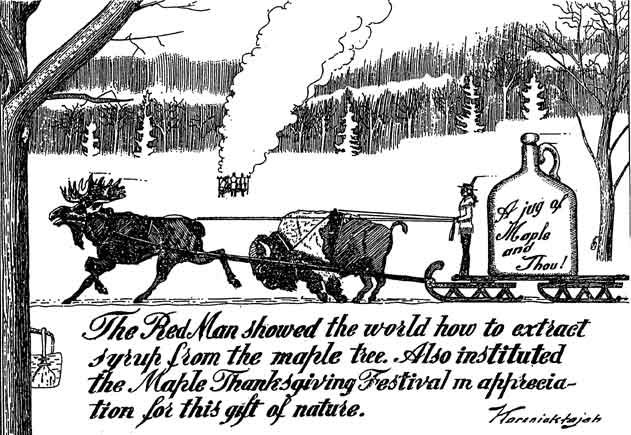When the sap is going good
Mitch’s older brother, George Amato, leans against the sled used to collect the maple harvest in Ganienkeh. Taken in the late 1970s. (Courtesy: Mitch Deer)
Story told by Mitch Deer
I used to work on maple syrup in Ganienkeh in 1977 till 1984. I had 1500 taps that I would tap myself.
I started in February when there’s still snow on the ground and I had to go through every tree, drilling the holes, putting in the plastic taps that go down to the lines.
The first year, I made 50 gallons of syrup. It takes anywhere from 25-40 gallons of sap to make one gallon of syrup. The second year, about 100. The third year was 150 gallons. The last year, I had 250 gallons.
We had no pumps. There's no electricity in the shack. There's kerosene lamps and that's it. So I had to do it in the daytime, when it’s light out. But sometimes I worked right into their night. Sometimes I’d boil around the clock.
Because when the sap is going good, you can't waste it. When it’s flowing like water.
Before, they used to make maple sugar by putting it in wet birch bark baskets and putting it on the fire. It was always wet so it didn’t burn through the wood. It was boiled that way, down to a sugar, to a powder.
They’d put it in leather pouches, it’d last longer like that. Sweeten their teas, make puddings. You could cook your deer meat with maple, that’s what they used to do.
Nó:nen ioiánere’ tsi ní:tsi iothnekahtentionhátie’ norontákeri
Painting by Karoniaktajeh Louis Hall (Courtesy: Ganienkeh Territory Council Fire)
Mitch Deer roká:raton
Ganienkeh shes wáhta watió’te’ 1977 tsi niió:re 1984 shiiohseratátie’. 1500 nika’wáhstake watién:tahkwe’ akonhà:’ak enke’wahstohrókhon’.
Enniskó:wa takatáhsawen’ shé:kon shikanié:ien tánon’ tsi ní:kon iokwiró:ton ó:nen’k tsi wa’kerontahrá:rake’, tánon’ onà:kara’ ionnià:ton wa’ke’wahstò:roke’. Nè:’e tewahsonterónnion ne ohonrò:ta’.
Tiotohseratierénhton, 50 kárehn wa’keshestón:ni’. Teiotonhontsóhon 25 tóka’ ni’ 40 kárehn ne orontákeri naieshestónnia’te’ énska kárehn ne óshes. Teiohserakéhaton, wa’keshestón:ni’ tóka’ 100 kárehn. Ne ahsénhaton niiohserakéhaton 150 kárehn. Nohna’kénhkha iohserá:te, 250 kárehn wakeshestaién:tahkwe’.
Iah teionkwaién:tahkwe’ ne iehnekatahkwà:tha’. Iah ò:ni’ tekaién:tahkwe’ ne ken’tonhkwarà:ken kanónhskon ne tsi ieshestonnià:tha’. Kwah nek ionthahseróhkhwa’ kaién:tahkwe’. Né: ká:ti’ ó:nen’k tsi entiehkè:ne ontió’ten’, shé:kon shiwén:te’. Nek tsi sewatié:rens ontió’ten’ tsi niió:re eniò:karahwe’.
Sewatié:rens enhniserakwé:kon tánon’ ahsontakwé:kon kerihà:tha’.
Nè:’e tsi nó:nen ioiánere’ tsi ní:tsi iothnekahtentionhatie’ norontákeri, iah ki’ thaón:ton’ ahsatié:sahte’. Nè:’e nó:nen tsi ní:ioht ne ohné:kanos tsi iothnekahtentionhátie’.
Wahón:nise’ tsi náhe’, watenakè:tarons ionnià:ton io’theranà:wens enhatihnekáta’ tánon’ tsi iotékha’ enhon’therà:ren’, tho ní:tsi wáhta enhatitsikhe’tón:ni’. Tiótkon ionà:nawen oh naiá:wen’ne’ tóhsa’ aóntsha’ tánon’ aiokahrón:ta’ne’ no’wá:tsiste’. Tho ní:ioht tsi karihà:tha’, tsi niió:re otsikhè:ta’ ienwá:ton’, othè:sera’ tsi ní:ioht.
Óhna’ ionnià:ton kahna’tahtsherá:kon enhonnéta’ ne otsikhè:ta’, tho ní:ioht tsi ísi’ nón: nikarì:wes enkaién:take’. Ia’tenhonttsikhè:tohwe’ ne raoná:wen tí:, tánon’ rabotsíhn enhonnón:ni’.
Aón:ton’ wáhta óshes áhsatste’ tsi enhse’wà:rarihte’ ne oskennón:ton, tho shes nihatiiéhrha’.
Edited by: Emma McLaughlin, Local Journalism Initiative Reporter
Translation by Sahawisó:ko’ Arquette


